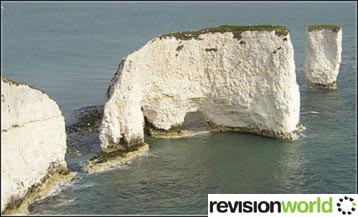Coastal Geology
Discordant coastline occurs where bands of differing rock type run perpendicular to the coast.
The differing resistance to erosion leads to the formation of headlands and bays.
A hard rock type is resistant to erosion and creates a promontory whilst a softer rock type is easily eroded creating a bay.

Part of the Dorset coastline in the UK running north from the Portland limestone of Durlston Head is a clear example of a discordant coastline.
The Portland limestone is resistant to erosion; then to the north there is Swanage Bay where the rock type is a softer greensand.
North of Swanage, the chalk outcrop creates the headland which includes Old Harry Rocks.

A concordant coastline occurs where the bands of differing rock types run parallel to the coast.
The outer hard provides a protective barrier to erosion of the softer rocks further inland.
Sometimes the outer hard rock is punctured allowing the sea to erode the softer rocks behind.
This creates a cove which is a circular area of water with a relatively narrow entrance way from the sea.

Lulworth Cove has occurred on a concordant coastline.
The outer hard rock is Portland limestone.
The sea has broken through this barrier and easily eroded the clays behind it.
A chalk cliff face is at the back of the cove.

